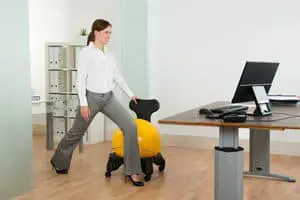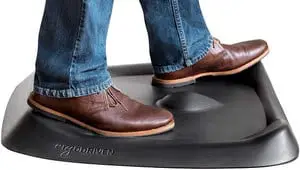Kicking back in a comfy recliner after a long day can be relaxing. You just want to be sure that your relaxing isn’t leading to lasting damage to your neck. Recliners can be a mixed bag for providing sufficient neck support. However, if you’re comfy, you’re probably doing just fine.
Are recliners bad for your neck? No, most recliners will provide adequate neck support, and can be adjusted to meet different body needs. You are unlikely to damage your neck by using a recliner chair, especially if you buy one from a reputable manufacturer.
While you are unlikely to get injured by relaxing in your recliner chair, there are certain steps you can take to ensure that your recliner chair, or any chair you are considering, provides the right support in the all-right places, especially your upper body. Let’s get right into it.
All content and media on Office Solution Pro are created and published online for informational purposes only. It is not intended as a substitute for professional medical advice and should not be relied on as health or personal advice. This post may contain affiliate links.
Recliners That Support Your Neck
Most recliners will support your neck naturally. At least they will try to support your neck. Nonetheless, how much adjusting you need to make your recliner fit your needs depends on your size. This is because every human being comes in different shapes and sizes. There’s no one-size-fits-all chair.
Recliners, for the most part, are designed for an average male body. This means that anyone taller than six feet or shorter than about five-feet-five-inches tall will likely have to either adjust their recliner to their body or buy a recliner designed specifically for their body size.
A good recliner that supports your neck will keep your upper vertebrae in the position they would be in if you were standing. If you aren’t sure what that should be or are concerned about how to know for certain that your recliner fits this qualification, don’t worry, we’ll cover all that next.
Testing a Recliner for Neck Support
When testing your recliner to ensure that it is the right fit for your neck (and the rest of your body), there are a few things to be aware of:
- Space between your neck and the chair
- The curve of your neck
- Space between your lower back and the chair
If there is space between either your neck or back and the chair when you sit, you will need to adjust this. It’s important to note these spaces because, when you are testing a chair, you tend to be tenser than when you flop into it at the end of a long day or doze off in it on a lazy afternoon. When your body is more relaxed, it will sink into the spaces that existed beforehand and throw your expected alignment off.
1. The Position of Your Neck
As stated before, the best position for your neck is where it naturally goes when you stand (provided you stand with proper posture). If your parents had you stand with your back to the wall or balance books on your head, you are probably well aware of what testing your posture looks like.
For those lucky enough to escape these lessons when you were younger, here’s how you know if you’re standing properly:
- Put your heels to a wall.
- Tuck your tailbone so your lumbar spine touches the wall (or thereabout).
- Lift your shoulders and roll them back so that your shoulder blades touch the wall.
- Touch the back of your head to the wall.
From your lumbar spine up, this is the position you should be in for a while in your recliner. Note that the ideal position for your neck situates your head directly over your shoulders. You do not want your head to fall forward.
2. Setting Up the Recliner
Once you know what to look for in your posture, you can go ahead and sit in your recliner. It might be useful, however, to grab a couple of towels or small blankets before you do, though.
If, when you sit back in your recliner, everything lines up as it did against the wall, you are set. Otherwise, use a small pillow or rolled-up towel to add support to wherever you need it. For your neck, you might consider adding the pillow in the space just under the base of your skull.
3. Fixing Your Support
Once you figure out where you need support, you will need to ensure that that support doesn’t move around too much as you get up and down.
Your best bet is to use a pillow to add not only more support for your neck, but more comfort as well. There are also lots of products online that help supports the neck while you relax in your recliner. We found a super comfy pillow with a free eye mask and earplugs. You can check it out right here.
Your Neck in Other Chairs

Your standard chair can be the cause of neck pain. It’s best to choose an office chair that supports your neck and upper body.
If you are experiencing neck pain, it’s likely not from sitting in your recliner but sitting in a standard chair. Anyone with a desk job is asked to sit for roughly eight hours a day. Not only is this far longer than your body would like to be sitting, but most chairs are also horribly designed for the human neck and back.
Most chairs will sit at a 90-degree angle. Your monitor, if you work at a computer, will also require that you look up or look down for a large part of the day. Looking at a computer screen for a prolonged time will inevitably put pressure on your neck.
According to the Mayo Clinic, the average human head is about 12 lbs. When you lean forward, however, the weight on the head increases. Leaning forward 45 degrees, for example, increases the weight the neck has to support to close to 50 lbs.
The extra weight your neck has to support for roughly eight hours a day is likely the culprit behind any neck pain you have. Your recliner chair probably isn’t at fault.
Supporting Your Neck Out of Your Recliner
If changing the support on your recliner to better align with your neck doesn’t help alleviate any neck pain, it’s likely caused by something else in your life. It could be that your neck is sensitive to the typical sitting position. In that case, investing in an office chair that fights neck pain will prove helpful.
If you can’t change your chair, however, these are simple steps you can take:
- For one, you can try to take more literal steps. Getting up periodically is the best way to relieve stress from your back, neck, and shoulders. Setting a timer for every 30 minutes will help keep you limber even through long stints of sitting. Plus, it makes having to run basic office tasks like printing or getting coffee part of a good daily schedule instead of interruptions to your workflow.
- You can also try adding in simple stretches for when your neck feels tight. Try the following simple stretches designed by the Cleveland Clinic to help relieve tension building in your neck.
Bottom Line
We hope that this post answers: are recliners bad for your neck? If you have neck pain, a recliner is a better choice than a traditional chair. Recliners are not only more supportive for your neck, but they are also a wise choice for your lower back. Nonetheless, it’s best to choose the right recliner chair that supports your body.
The only downside to a recliner is that it might not be designed for your body type. If you have neck pain even after you fix your recliner, be sure to follow the simple steps above to help alleviate the tension in your neck. Just take comfort in knowing that your recliner can be a part of the solution to your neck pain. 🙂







